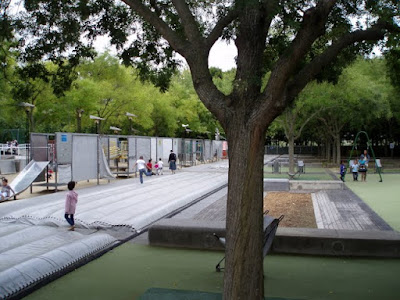This looks like a mini-golf course but it is actually a children's playground. There are hamster-wheel treadmills and a bouncy running track as well as more traditional toys. Each area is given an age-range so you know which toys are appropriate for your child. For example Children age 0-2 are not allowed on the bouncy track, but they are allowed on the very steeply graded hills. Hmmm...I would keep a close eye on them, especially those rolly newborns.
Running through the park is the Canal d'Ourcq, providing about half of the water required to clean the city's sewer system, gutters, and parks.
Here is a nice sunny view of people enjoying the grass -- I like the guy who is completely sprawled out in the center. The red structures are "follies" that were designed to "act as architectural representations of deconstruction" (according to wikipedia). Whatever that means. Some of them have been turned into restaurants and ice cream shops. Behind the folly is the reflective silver geode (an IMAX theater) and the blue beams of the Science and Industry museum.
The 400-ton Argonaute submarine is a former flagship of a French squadron. It was decommissioned in 1982 after 2000 days at sea and 32,000 hours underwater. The submarine actually transited the canal system via the 7 locks in the Canal Saint-Denis before being hoisted to its current location by crane. Visitors can view the interior's crew stations, periscope, radar detectors, and torpedo launch housing.
The Cité des Sciences et de l'Industrie is the largest science museum museum in Europe. Construction began in the 1970's and it was initially intended to be an enormous slaughterhouse facility. But once they decided to move everything to do with the abattoirs they had to repurpose the uncompleted structure, so it was transformed into a science museum.
The exhibits are all very interactive, and some are even available in other languages. We got a kick out of the Transport exhibit. Apparently it is possible to ride a camel in an evening dress and heels.











No comments:
Post a Comment